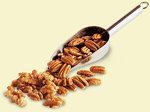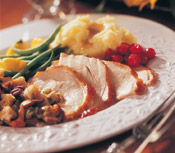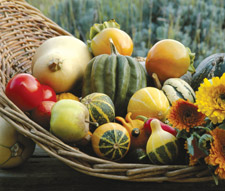Good news about traditional holiday foods
by Karen McGeorge Sanders
This article was originally published in December 2004


(December 2004) — Traditional holiday foods don’t always deserve the blame for your extra holiday pounds. Despite their weighty reputation, many of them are good for you both nutritionally and calorically. To give them their due, let’s look at the health benefits of today’s holiday table mainstays — cranberries, sweet potatoes, pumpkins, nuts and turkeys. You’ll like what you’ll learn.
Cranberries
The red berries used in holiday relish are from the North American cranberry, Vaccinium macrocarpon. Cranberries are high in vitamins, antioxidants and flavonoids. Flavonoids and antioxidants are believed to reduce cardiovascular disease by inhibiting blood clotting and promoting vasodilatation. A University of Scranton study shows cranberries help protect against the oxidation of cholesterol, thus reducing clogging of the arteries.
According to Israeli researchers, cranberries, especially when served as unsweetened juice, may also prevent plaque-forming bacteria from binding to teeth, causing gingivitis and gum disease. A study in Critical Review in Food Science and Nutrition (2002) proved that a mouthwash containing cranberries helped reduce the oral streptococcus population.
Following an old folk remedy, people often use cranberries to treat urinary tract infections (UTIs). The prevailing theory is that a compound in cranberries, possibly condensed tannin, inhibits bacteria from adhering to the mucous membranes lining the urinary tract, thus preventing infection. Not all bacteria are thus equally affected, but E. coli, a frequent cause of UTIs, is sensitive to this fruit.
Cranberries are harvested in September and October. They’re sold fresh, frozen, dried and canned. Fresh cranberries should be full and plump.
Cautions: Many commercially grown cranberries are heavily sprayed; concerned consumers may want to choose organically grown varieties. Many cranberry juice cocktails are blended with water, sweeteners and other juices. These sweetened, part-cranberry drinks have lower amounts of antioxidants than actual cranberries.
It is also important to be aware that cranberries may interfere with other medications, especially those for kidneys or the urinary tract. For example, cranberries’ acidifying effect lessens the impact of an herb called uva ursi; they should not be taken together.

Pumpkin
A winter squash of the vine crops family cucurbits, the pumpkin is a hard-shelled gourd related to watermelons and muskmelons. The pumpkin’s bright orange color is a clue that this gourd is loaded with beta-carotene, an antioxidant which converts to vitamin A when eaten. Low in calories, pumpkins are also rich in fiber, potassium, riboflavin, vitamins C and E, plus other carotenoid pigments.
Although pumpkins were once recommended for removing freckles and curing snakebites, their health benefits today are based on more scientific nutritional studies. Current research indicates that foods rich in beta-carotene may reduce the risk of certain types of cancer, protect against heart disease, and slow some of the degenerative effects of aging.
“Pumpkin seeds are an excellent way to add protein to your diet,” recommends Dr. Joseph Mercola, author of the “Total Health Program.” Besides protein, pumpkin seeds are loaded with fiber, iron, copper, magnesium, manganese, phosphorus and linolenic acid, which may help prevent hardening of the arteries. These seeds have a rich, peanuty flavor when roasted. Preliminary studies have shown that pumpkin seeds may reduce the risk of prostate cancer.
There are many varieties of pumpkins. Connecticut Field pumpkins, often used for jack-o’-lanterns, are stringy and a poor choice for eating. For consumption, you could select Sugar Pie pumpkins, which have close-grained flesh and are smaller and sweeter than decorative pumpkins. After cleaning out the insides, remember to save the seeds for roasting. You can bake, boil, steam, microwave or sauté them for hearty eating.
Fresh pumpkins are available in the fall. Canned pumpkin, however, is fine for cooking and available all year.
Cautions: When buying canned pumpkin, avoid those with added sweeteners, spices and artificial preservatives. Pumpkins spoil quickly; so if you carve a pumpkin and leave it at room temperature, don’t eat it.

Sweet Potatoes
The sweet potato is one of the world’s most nutritious vegetables, high in fiber content, complex carbohydrates, vitamins, iron and calcium. There are two types of sweet potato: moist (orange-fleshed) and dry (yellow-fleshed), with the sweet, moist variety currently dominating the U.S. market.
Eaten with the skin, sweet potatoes are a good source of dietary fiber for lowering the risk of colon and rectal cancer, constipation and obesity. Their color is a clue to their high beta-carotene content, and they also contain the carotenoids, lutein and zeaxanthin.
Dr. Robert Cordell, cardiothoracic surgery professor at Wake Forest University of Medicine, says, “Most remain unaware of the significant health benefits of this low-fat, high-fiber vegetable that’s such a rich source of vitamins A and E. Sweet potatoes, therefore, contain significant deterrents to heart disease and stroke. In addition, reports have suggested anti-cancer effects. With these facts in mind, all of us should make sweet potatoes a more frequent part of our regular diet.”
Select fresh sweet potatoes that are heavy, smooth and hard, and free of bruises or decay that may appear as black or shriveled spots. These may make the whole potato taste bad. Store whole potatoes in a cool place but never in the refrigerator. Storing sweet potatoes at low temperatures converts their natural sugars to starch so they may develop a hard core and an “off” taste.
Sweet potatoes can be bought fresh, frozen or canned. Fresh sweet potatoes can be baked, boiled or microwaved.
Cautions: Canned sweet potatoes are substantially lower in beta-carotene and vitamins B and C. Canned sweet potatoes may also be packed in heavy sugary syrup. Overindulging in sweet potatoes may cause abdominal swelling and indigestion.

Nuts
Most nuts are the seeds or dried fruits of trees, their inner kernels usually protected with a hard, woody husk. Long considered forbidden to calorie counting dieters, nuts are proving to have many health benefits. For example, they derive 8 to 18 percent of their calories from protein. Although it’s an incomplete protein, since nuts lack the amino acid lysine, you can add other dietary protein sources to supplement.
Nuts are rich in potassium and iron and are one of the best vegetarian sources of vitamin E, which studies indicate prevent heart disease, and many B vitamins and minerals. Although high in fat, much of it is unsaturated, including heart-healthy alpha-linolenic acid, a precursor to omega-3 fatty acids. Thus for vegetarians, nuts are a good source of omega-3 fatty acids.
When selecting nuts with a shell, look for undamaged shells with no cracks, scars or wormholes, or heavy ones with no rattling, which could indicate that the inner kernel is withered and dry. Shelled kernels should be crisp and fresh, not limp, rubbery, or musty.
Most unshelled nuts store well, up to a year when stored in a cool dry place. Shelled nuts can be stored in their original manufacturer’s bag, unopened, for three to four months at room temperature. Shelled nuts can be frozen for up to a year, but don’t chop whole nuts until they’re needed. Nuts can be used raw, blanched, boiled, toasted or roasted in the oven or over a fire.
Cautions: Many people are allergic to nuts. Dieters may find that nuts need to be eaten in moderation. Because of their high fat content, nuts are prone to turning rancid.

Turkey
Although turkey is still a holiday staple, today’s celebrants are likely to offer a different kind of meat or a vegetarian dish as their dinner centerpiece. But for nonvegetarians, turkey is an excellent protein source. Turkey is also low in fat and a good source of B vitamins, phosphorus, selenium and zinc.
For many natural food consumers, the way a turkey is grown and the added chemicals can be a concern, and a choice must be made. Will you serve free range or organic? They’re different.
Free range is defined by the U.S. Department of Agriculture as poultry with “access to outside,” although the USDA doesn’t specify a minimum time requirement. The term free range can be applied only to poultry.
Certified organic defined by the USDA is free range, and in addition, is fed 100 percent certified organic feed from day one. This means non-GMO feed. Organic regulations also exclude antibiotics.
Regarding hormones in poultry, take note. Watch for meaningless labels on poultry that claim “no added hormones” or “no artificial hormones.” Unlike cattle, poultry never are fed hormones for quicker weight gain.
Cautions: Turkey left out at room temperature for more than two hours is susceptible to bacterial contamination that can make humans sick. Stuffing is especially prone to bacterial contamination, so after roasting the bird, it’s best to remove the stuffing promptly to a separate dish.

Prepare with care
As you can see, these traditional holiday foods are so nutritious they should be a standard part of your diet. They’re not inherently fattening; it’s how they are prepared that may add extra calories. Without the added “holiday recipe” sauces or sugar, you can enjoy the taste and benefits of cranberries, sweet potatoes, pumpkin, nuts and turkey year round, assuring them their rightful place in a healthy diet.
